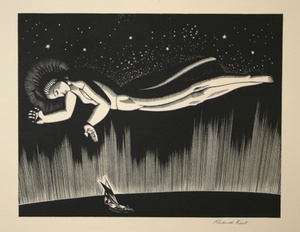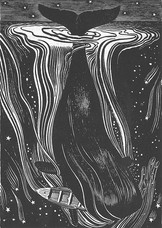Noticing what you notice
- kassandraaloe
- Sep 29, 2024
- 4 min read
Updated: Nov 9, 2024
A roundabout path to finding the driving questions of my art

I painted this illustration of the secret garden last summer for my literary tarot project. To create the visual of the Secret Garden door hidden behind a wall I gathered a lot of references of vines. I took photos of vines growing on the walls of the dog park in our neighborhood and overtaking the chain link fence that surround the train track, and wherever I noticed them on my commutes or walks.

After finishing the painting I found that I was still photographing vines. Ivy smothering a hospital parking garage, framing the window of a gallery, the tangled mass of leaves and tendrils around the iron wrought fence of a cemetery. The images were compelling in the varied greens and soft forms, but at the same time daunting in their visual density. I wanted to create a piece
using my collection of references. At first I had planned to combine the vines with text. I had just finished adding text to three of my literary tarot cards and I found painting letters and font to be a calming and satisfying exercise. I thought the vines could overtake the words in the same way they took over these human built structures all around me. But what words should I use? I began with my favorite quote from the Unbearable Lightness of Being.

However as I paired the words with the messy vines of my photos I realized it was all wrong. The imagery in the quote was of music, composition, order. I switched to a lyric from the musical Into the Woods to connect visually with the foliage.
The way is clear, the light is good
I have no fear, nor no one should
The woods are just trees
The trees are just wood
No need to be afraid there
There's something in the glade there
The song pretends to be unafraid of the wildness of the woods. While the imagery was more aligned, I still felt unsatisfied with the quote. Next I found a quote I had written down from Philip Pullman's essay entitled "The Path through the Woods" in his book Daemon Voices: Essays on Storytelling. The essay uses the metaphor of the woods to describe the process of world building (the wood) compared to structure of your plot (the path)... At this point I was feeling lost- what did I want to say with this piece! Vines are not woods or trees and most often they are taking over human made structures. They are an image of nature or wildness reentering the civilized world and reclaiming it. This is the beauty I see in these images. So I continued to search for the perfect quote. I took out my copy of Clarissa Pinkola Estés' Women Who Run With the Wolves, a book that addresses the return to wildness and nature. At this point I became flooded with connections.
The illustration on the cover reminded me of one of my favorite artists Rockwell Kent. An artist who famously illustrated Moby Dick, where man and nature battle, and who lived and worked in the isolated wilds of Alaska. I flipped through the chapters and recalled all of the myths the Estés used to illustrate how women can connect to their wildness. I started combing my book shelf- almost every non fiction book I own is related to myths, or making stories. Goddesses by John Campbell, Women Who Fly by Serena Young. More Philip Pullman books including his retelling of Grimm's Fairy Tales. I also pulled out my copy of Milan Kundera's The Unbearable Lightness of Being the book where my search for the right words began. The cover had a floating bowler hat, the classic motif of Rene Magritte another favorite artist. My Streetlight Series has echoes of Magritte's the Empire of Light series. Estés wrote a book on dream interpretation and my comics are focus on dreams I have had often featuring mythic themes and characters. The protagonist in Pullmans novel The Golden Compass, was featured in my interpretation of the Fool tarot card. I began to collage all of these connections together.

Over the top of the collage I drew in vines to connect all pieces of my inspiration together and reflect once again on the patterns I noticed. Perhaps the Milan Kundera quote was not so disconnected from the imagery of vines as I thought. The overarching theme found across these books and thinkers is that stories and myths help us understand and make meaning in our lives. At times our lives can feel unbearably light, but stories give structure and meaning to our lives nourishing us and connecting us to humanity. I reexamine the image of the vines as they grow over the parking garages and chain link fences. The mundane is rendered softer, complex and living. The edges of the structure literally grow and expand with the reaching tendrils of the vines. The plants roots connect the human made structures to the earth, grounding them. Like the vines, stories are what help me feel connected to humanity, what soften the edges of my walls so I can see my shape, but what also allows for my complexity to exist as connect and relate to stories of diverse characters and experiences. My early intuition to combine vines with text is consistent with this theme. Meanwhile I have not begun the piece that initiated this rabbit hole of reflection, however the journey has been worth the while. I will leave with this digital collage of my photo references which unintentionally and intuitively connected to another favorite book and illustration: The Lampost in the woods from C.S. Lewis's The Lion, The Witch and the Wardrobe.











































Comments